
This is a survey of the postage stamps and postal history of Tibet.

This is a survey of the postage stamps and postal history of Tibet.
The first adhesive stamps issued for use in Tibet were typewritten overprints on Indian postage stamps [1] through the 1903 period, during which the Tibetan Frontier Commission, led by Sir Francis Younghusband, arrived in Kamba Dzong on July 7, 1903. [2] Soon after, as no progress was made in diplomatically settling issues of the Tibetan border with Sikkim, this became a military expedition. One result of the treaty signed September 7, 1904, was the establishment of Indian Postal Agencies at Gartok, in Western Tibet, and Gyantse, Pharijong and Yatung, along the Indian trade route to Lhasa. [2] Chinese forces occupied Tibet in 1909, when the Dalai Lama fled into Sikkim and India. However, there were Chinese communities in Tibet well before this, as shown by a registered letter from Wen Tsung-yao at Lhasa, January 9, 1909. Thereafter, Chinese stamps and special Chinese date stamps were used at Chabdo, Gyantse, Lhasa, Phari Dzong, Shigatse and Yatung. Postal communications of this period are scarce and eagerly sought after by both Chinese and Tibetan specialists. [2]

Tibet began issuing postage stamps at the beginning of the 20th century. The first stamps were issued in Lhasa in 1912. Other series of stamps were issued in 1914, 1933, and through the end of the 1950s.
Tibetan stamps had a figure of a snowlion, the national emblem of Tibet. The stamps were marked in Tibetan characters meaning "Tibet Government" and in English by "Tibet". [3]

Collectors and philatelists encounter many fakes and forgeries of both Tibetan stamps and cancellations. Genuine postally used material also has been produced for collectors. [2]
References
Sources

Samzhubzê District is a district in the Tibet Autonomous Region of the China, and the administrative center of the prefecture-level city of Shigatse. Prior to 2014 it was known as the county-level city of Shigatse. It was the ancient capital of Ü-Tsang province and is the second largest city in Tibet with an estimated population of 117,000 in 2013. Samzhubzê is located at the confluence of the Yarlung Tsangpo River and the Nyang River, about 250 km (160 mi) southwest of Lhasa and 90 km (56 mi) northwest of Gyantse, at an altitude of 3,840 metres (12,600 ft).
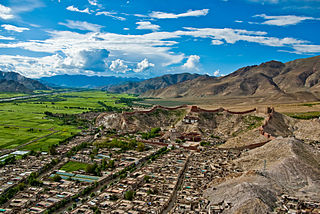
Gyantse, officially Gyangzê Town, is a town located in Gyantse County, Shigatse Prefecture, Tibet Autonomous Region, China. It was historically considered the third largest and most prominent town in the Tibet region, but there are now at least ten larger Tibetan cities.

Yadong County, also known by its Tibetan name Dromo/TromoCounty is a frontier county and trade-market of the Tibet Autonomous Region of China, part of its Shigatse Prefecture.
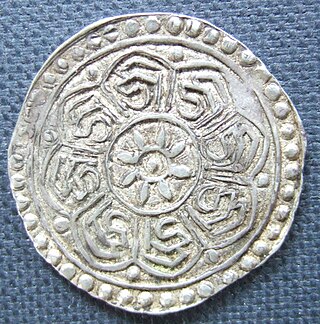
The tangka was a currency of Tibet until 1941. It was subdivided into 15 skar or 1+1⁄2sho and, from 1909, it circulated alongside the srang, worth 10 sho.

The British expedition to Tibet, also known as the Younghusband expedition, began in December 1903 and lasted until September 1904. The expedition was effectively a temporary invasion by British Indian Armed Forces under the auspices of the Tibet Frontier Commission, whose purported mission was to establish diplomatic relations and resolve the dispute over the border between Tibet and Sikkim. In the nineteenth century, the British had conquered Burma and Sikkim, with the whole southern flank of Tibet coming under the control of the British Indian Empire. Tibet ruled by the Dalai Lama under the Ganden Phodrang government was a Himalayan state under the protectorate of the Chinese Qing dynasty until the 1911 Revolution, after which a period of de facto Tibetan independence (1912–1951) followed.

John Harry Robson Lowe was an English professional philatelist, stamp dealer and stamp auctioneer.

Sir Charles Alfred Bell was the British Political Officer for Bhutan, Sikkim and Tibet. He was known as "British India's ambassador to Tibet" before retiring and becoming a noted tibetologist.

Yatung or Yadong, also known as Shasima , is the principal town in the Chumbi Valley or Yadong County in the Tibet Autonomous Region of China. It is also its administrative headquarters.
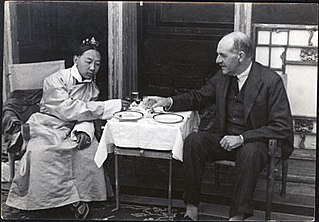
Sir Basil John Gould, CMG, CIE was a British Political Officer in Sikkim, Bhutan and Tibet from 1935 to 1945.

Agvan Lobsan Dorzhiev was a Russian-born monk of the Gelug school of Tibetan Buddhism, sometimes referred by his scholarly title as Tsenyi Khempo. He was popularly known as the Sokpo Tsеnshab Ngawang Lobsang to the Tibetans.

Tibet was a de facto independent state in East Asia that lasted from the collapse of the Manchu-led Qing dynasty in 1912 until its annexation by the People's Republic of China in 1951.

Nepal has a long postal history. The modern form of postal service was started by the Rana Prime minister Ranaudip Singh in 1878. He established the first post office which was named Nepal Hulak Ghar. In 1881, the first postal stamp was issued. As of 2020, about 1367 types of postal stamps have been issued. Currently, the postal service is regulated by the Postal act of Nepal. Nepal Post, locally known as Hulak Sewa(Nepali: हुलाक सेवा विभाग) or Daak Sewa(Nepali: डाँक सेवा) under the Ministry of Information and Communications is responsible for the postal service in Nepal.
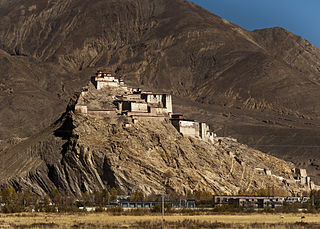
Gyantse Dzong or Gyantse Fortress is one of the best preserved dzongs in Tibet, perched high above the town of Gyantse on a huge spur of grey brown rock.

Wolfgang C. Hellrigl was an expert on the philately of Nepal and Tibet who in 1994 was invited to sign the Roll of Distinguished Philatelists.
Arnold Cartwright Waterfall was a philatelist who was a specialist in the stamps of Tibet. He wrote extensive on the subject and his articles appeared in Gibbons Stamp Monthly, the China Clipper, the Collectors' Club Philatelist, the China Philatelic Society Bulletin and The Philatelist. His The postal history of Tibet was written after thirty years of personal research and included the information that some Tibetan stamps were printed using house paint and that soot or boot polish were sometimes used to cancel stamps.
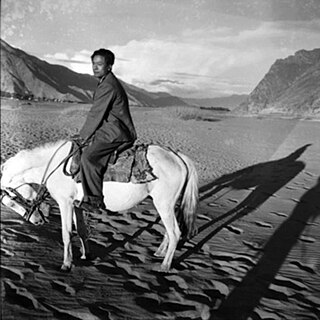
Pratek Man Tuladhar (1924–1991) was a Nepalese trader and philatelist. Born in Kathmandu into a family of hereditary merchants, he spent his youth in Lhasa, Tibet, where they owned a business house.

Tibet under Qing rule refers to the Qing dynasty's rule over Tibet from 1720 to 1912. The Qing rulers incorporated Tibet into the empire along with other Inner Asia territories, although the actual extent of the Qing dynasty's control over Tibet during this period has been the subject of political debate. The Qing called Tibet a fanbu, fanbang or fanshu, which has usually been translated as "vassal", "vassal state", or "borderlands", along with areas like Xinjiang and Mongolia. Like the preceding Yuan dynasty, the Manchus of the Qing dynasty exerted military and administrative control over Tibet, while granting it a degree of political autonomy.

The Convention of Lhasa, officially the Convention Between Great Britain and Thibet, was a treaty signed in 1904 between Tibet and Great Britain, in Lhasa, the capital of Tibet, then a protectorate of the Qing dynasty. It was signed following the British expedition to Tibet of 1903–1904, a military expedition led by Colonel Francis Younghusband, and was followed by the Anglo-Chinese Convention of 1906.

Chumbi is a historic village in the Chumbi Valley or the Yadong County of the Tibet Autonomous Region of China. It is in the valley of the Amo Chu River, where the route from Sikkim's Cho La Pass meets the Amo Chu Valley. The "Chumbi Valley" of the European nomenclature derives its name from the village of Chumbi. It was the administrative center of the lower Chumbi Valley until the Chinese take-over of Tibet in 1950, after which Yatung became its headquarters. Chumbi is also associated with the Sikkim's royal family, which had a summer palace in the village.

Lobsang Tashi, also known as Khenchen Lobsang Tashi (1897–1966) was a Tibetan politician who was a senior monastic official and the monastic prime minister (sileun) of the Tibetan government during the early Chinese occupation of Tibet. After the departure of the 14th Dalai Lama in 1959, he was incarcerated in Drapchi Prison where he died in 1966.